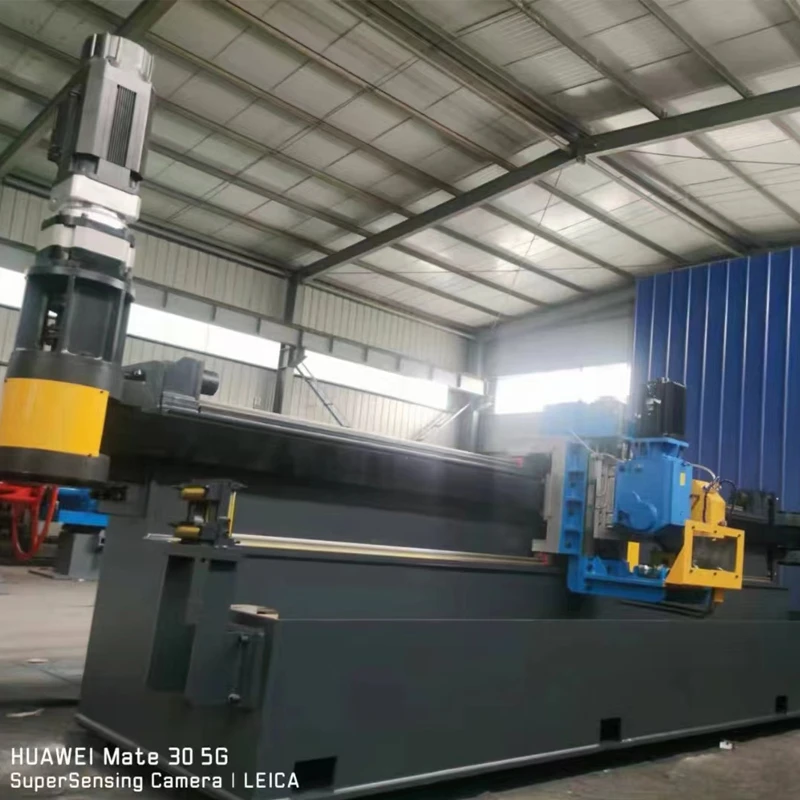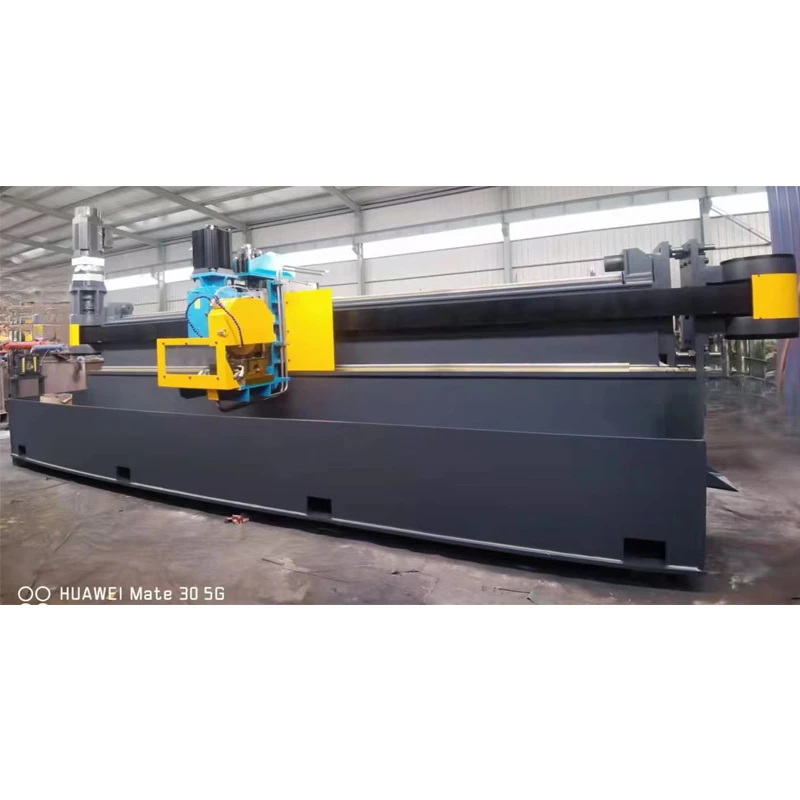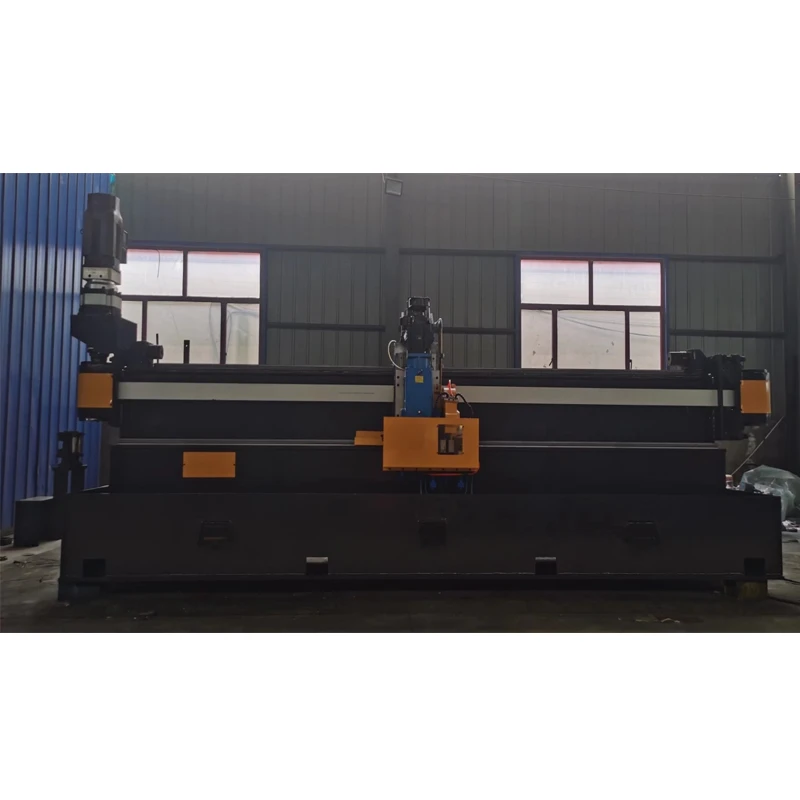Precision Flying Saw & Shear Machines for High-Speed Cutting
Understanding the Core Technology: Cold Cutting Flying Saw
In high-speed production lines, precision and efficiency are paramount. The flying saw stands as a critical component, enabling continuous processing without interrupting the material flow. Specifically, the Cold Cutting Flying Saw, a sophisticated variant, offers unparalleled advantages in industries demanding a burr-free finish and minimal material deformation. Unlike traditional hot shears that rely on thermal processes, cold cutting maintains the material's structural integrity, making it ideal for high-quality finished products like pipes, tubes, and profiles. This advanced technology integrates sophisticated control systems, robust mechanical designs, and high-performance cutting tools to deliver precise cuts on the fly, significantly boosting productivity and product quality in modern manufacturing environments.
The primary function of a flying shear is to perform synchronized cutting on continuously moving material. This necessitates an intricate control system, often featuring high-speed PLC (Programmable Logic Controller) or industrial PC-based solutions, coupled with precise servo drive systems. These components work in harmony to match the material speed, execute the cut, and then rapidly return to the starting position for the next cycle. The "cold cutting" aspect implies cutting at ambient or slightly elevated temperatures, using saw blades or specialized shear blades, ensuring a clean edge without heat-affected zones. This method is particularly vital for applications where subsequent processing, such as welding or bending, requires an uncompromised material structure. A specialized variant of the flying saw, it exemplifies efficiency in high-volume production.
The Manufacturing Journey: From Raw Material to Precision Tool
The production of a high-performance flying shear machine involves a multi-stage, rigorously controlled manufacturing process, ensuring durability, precision, and longevity. It begins with the selection of premium-grade materials, such as high-strength alloy steels (e.g., S355JR for structural components, AISI 4140 for critical shafts, and specialized tool steels for cutting blades) known for their superior wear resistance and mechanical properties. These materials undergo initial processing, which may include forging or casting to achieve the preliminary form, followed by stress relief to enhance stability. Subsequent stages involve precision CNC machining, where complex geometries and tight tolerances are achieved for components like gearboxes, guide rails, and clamping mechanisms. Heat treatment processes, such as quenching and tempering, are applied to critical parts to optimize hardness and toughness. Surface finishing techniques, including grinding and specialized coatings, further reduce friction and enhance corrosion resistance, extending the product's service life, particularly in harsh industrial environments like those found in the petrochemical or metallurgy sectors.
Quality control is embedded throughout the entire manufacturing flow. Components are rigorously inspected against international standards such as ISO 9001 for quality management, ANSI B16.34 for general engineering tolerances, and ASTM for material specifications. Non-destructive testing (NDT) methods like ultrasonic testing and magnetic particle inspection are routinely employed to detect internal flaws. This meticulous approach ensures that each flying saw meets stringent performance criteria, offering exceptional reliability and a projected service life exceeding 15-20 years under typical operating conditions, significantly contributing to energy savings and anti-corrosion properties in challenging applications like water supply and drainage systems, where material integrity is paramount.

Technical Specifications and Performance Benchmarks
The effectiveness of a cold cutting flying saw is defined by its ability to perform precise, high-speed cuts on a continuous production line. Key technical parameters dictate its suitability for various industrial applications, influencing everything from throughput to operational costs. These parameters include cutting speed, which directly impacts production throughput; cutting accuracy, typically measured in millimeters of tolerance to ensure downstream compatibility; and the range of material dimensions it can handle. Understanding these specifications is crucial for optimizing line efficiency and ensuring product quality, allowing industries to meet demanding production targets with confidence. Each component of a high-performance flying saw is meticulously designed to achieve these benchmarks.

These parameters are critical in selecting the appropriate flying saw machine for a given production line. For instance, a tube mill producing high-precision stainless steel tubes would prioritize cutting accuracy and burr-free cuts, demanding a machine with advanced servo control and high-quality carbide-tipped blades. Conversely, a rebar production line might prioritize sheer cutting speed and robust construction. The precise synchronization achieved through advanced encoder feedback and high-speed motion controllers ensures that the saw precisely matches the material's speed, eliminating distortion and ensuring consistent product quality across millions of cuts.
Diverse Applications and Industry Impact
The versatility of the flying saw makes it indispensable across a spectrum of heavy industries. Its primary utility lies in continuous manufacturing processes where interrupting the material flow is neither practical nor desirable. In steel mills, it's crucial for cutting structural beams, railway tracks, and large-diameter pipes as they exit the rolling mill. For tube and pipe manufacturers, cold cutting flying saws are essential for producing exact lengths of welded or seamless pipes used in construction, automotive, and oil & gas sectors, ensuring high-quality end products ready for immediate further processing or delivery. For optimal performance, choosing the right flying saw model is key.
Beyond traditional metalworking, applications extend to industries requiring precise cutting of continuous profiles, even in scenarios involving non-ferrous metals where an air metal shear might also be considered for lighter gauge materials. The benefits are significant: reduced production bottlenecks, improved safety by minimizing manual intervention, and consistent product quality that meets stringent industry standards. Companies deploying these systems report substantial increases in throughput, lower operational costs due to reduced material waste, and enhanced overall line efficiency, contributing directly to their competitive advantage in the global market.
Manufacturer Comparison and Tailored Solutions
When investing in a cold cutting flying saw, selecting the right manufacturer is paramount. While many companies offer such equipment, distinctions in technology, support, and customization capabilities can significantly impact long-term operational success. XH Equipment differentiates itself through a blend of cutting-edge technology, robust engineering, and a client-centric approach to customized solutions, ensuring that each machine perfectly integrates into existing or planned production lines.
XH Equipment excels in offering highly customizable solutions. Our engineering team works closely with clients to develop a flying shear tailored to their specific operational requirements, whether it's for unique material compositions, high-speed production lines, or integration into complex existing systems. This bespoke approach ensures maximum efficiency and performance, setting XH Equipment apart as a partner in your long-term production success. Our proven track record, built over years of service to global industrial leaders, underscores our authoritative position in the market. XH Equipment's advanced flying saw solutions are designed for longevity and peak performance.

Building Trust: Quality Assurance, Support, and FAQ
Trust in industrial equipment is built on consistent performance, reliable support, and transparent processes. XH Equipment is committed to upholding the highest standards of quality and customer service for every flying saw we deliver. Our comprehensive quality assurance protocols adhere to international benchmarks, ensuring that each machine leaves our facility ready for demanding industrial applications with a proven track record. This commitment extends to providing robust after-sales support, continuous technical assistance, and clear warranty terms, giving our clients complete peace of mind and demonstrating our unwavering dedication to their operational success.
Warranty and Support
- ✓ Comprehensive Warranty: All Cold Cutting Flying Saws come with a standard 12-month warranty covering manufacturing defects and major components, extendable upon request.
- ✓ Dedicated Customer Support: Our expert technical support team is available via phone, email, and live chat to assist with installation, operation, and troubleshooting.
- ✓ Spare Parts Availability: We maintain a robust inventory of critical spare parts, ensuring rapid replacement and minimal downtime.
- ✓ Delivery Cycle: Typical delivery time for standard models is 8-12 weeks from order confirmation, with customized solutions requiring 14-20 weeks depending on complexity.
Frequently Asked Questions (FAQ)
Q: What is the primary advantage of cold cutting over hot cutting in a flying shear system?
A: Cold cutting ensures a burr-free, clean cut with minimal heat-affected zones, preserving the material's metallurgical properties and reducing the need for secondary finishing operations. This is critical for high-quality finished products.
Q: How does the control system ensure cutting accuracy for a flying shear machine?
A: Our machines utilize advanced PLC-based control systems coupled with high-resolution encoders and precision servo drives. This ensures precise synchronization of the saw carriage with the material speed, allowing for accurate length measurement and exact cut positioning even at high line speeds.
Q: Can your flying shear design be integrated into existing production lines?
A: Yes, our engineering team specializes in designing and manufacturing custom flying saws that can be seamlessly integrated into a wide range of existing production setups. We offer comprehensive assessment and integration services to ensure compatibility and optimal performance.
Further Reading & References
- Smith, J. (2018). Advanced Motion Control in Industrial Automation. Proceedings of the International Conference on Robotics and Automation, Vol. 42, pp. 123-130.
- Wang, L., & Chen, Y. (2020). Optimization of Synchronization Control for Continuous Production Lines. Journal of Manufacturing Systems Engineering, Vol. 15, No. 3, pp. 201-215.
- Miller, D. (2019). Material Properties and Cold Working Effects on High-Strength Steels. Metallurgical Transactions A, Vol. 50, Issue 7, pp. 3125-3138.
- ISO 9001:2015. Quality Management Systems – Requirements. International Organization for Standardization.
-
Top Hose Crimper Sales: Hydraulic, Manual & Electric OptionsNewsAug.28,2025
-
Precision Belling Machine | Automated Pipe End FormingNewsAug.27,2025
-
High-Efficiency Automatic Belling Machine for PipesNewsAug.26,2025
-
High-Quality Line Pipe Steel for Oil & Gas PipelinesNewsAug.21,2025
-
Advanced PVC Belling Machine for Efficient Pipe ProductionNewsAug.19,2025
-
High-Frequency Straight Seam Welded Pipe Production Line-BzZhou Xinghua Machinery Equipment Manufacturing Co., Ltd.|Steel Pipe Manufacturing, Precision EngineeringNewsAug.18,2025


